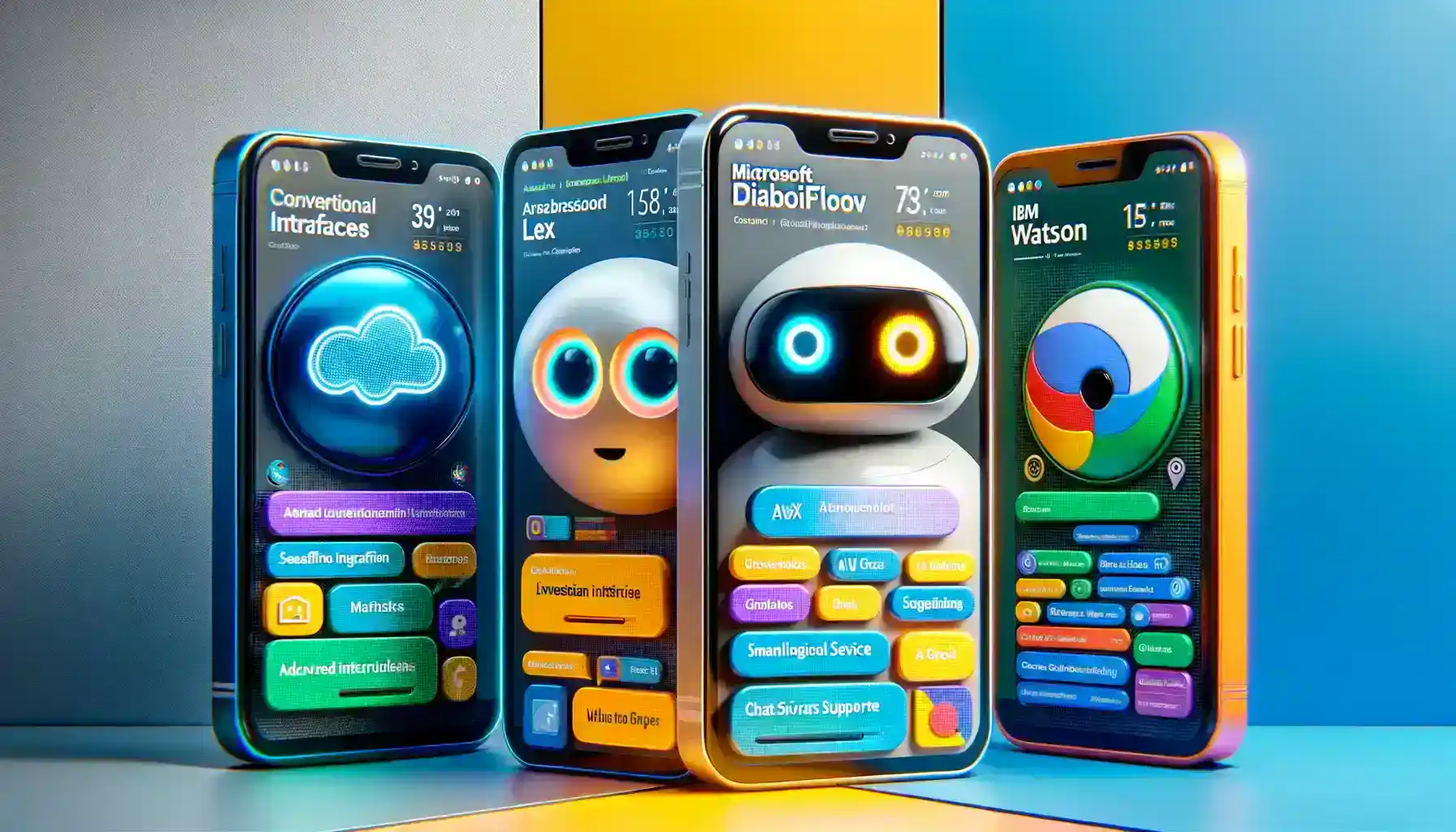Table of Contents
Introduction: Conversational Interfaces Redefined
In the dynamic landscape of digital interactions, where user experience reigns supreme, the evolution of conversational interfaces has taken center stage. The ability to engage users in natural, meaningful conversations has become a hallmark of successful applications, and among the myriad tools available, one stands out as a beacon of innovation: AWS Lex.
Welcome to our comprehensive guide, where we embark on a journey into the realm of conversational interfaces, unraveling the intricacies of AWS Lex and venturing into the landscape of other leading tools. From the fundamental building blocks of Lex to the nuanced design principles that shape effective conversations, this guide is your passport to mastering the art of chatbot development.
Crafting Conversations: From Basic Chatbots to Advanced Interactions
As we delve into the practical aspects of AWS Lex, we’ll guide you through the creation of a simple chatbot and then elevate its capabilities with advanced features. From customizing responses using Lambda functions to managing multi-turn conversations, you’ll gain a comprehensive understanding of how to design chatbots that not only respond but truly engage with users, emphasizing the importance of Conversational Interfaces.
But this guide is not limited to AWS Lex alone. In the spirit of exploration, we’ll conduct a comparative analysis with other leading tools such as Microsoft Azure Bot Service, Google Dialogflow, and IBM Watson Assistant, specifically considering their implementations of Conversational Interfaces. By understanding the strengths and nuances of each, you’ll be equipped to make informed decisions based on your project’s unique requirements.
Understanding AWS Lex

Overview of AWS Lex
Amazon Lex, part of Amazon Web Services (AWS), is a service for building conversational interfaces into applications. With Lex, developers can create chatbots capable of natural language understanding and interaction. The service supports both voice and text-based conversations, making it a flexible solution for a variety of applications.
Building Blocks of AWS Lex
At the heart of AWS Lex are its building blocks – Intents, Utterances, and Slots. Intents define the purpose of the user’s input, Utterances are examples of what a user might say, and Slots are placeholders for the specific data a user provides. Understanding these components is crucial for designing effective conversation flows.
Integration with Other AWS Services
AWS Lex seamlessly integrates with other AWS services, extending its capabilities. By connecting Lex with Lambda functions, developers can execute custom code in response to user input. Additionally, integration with Amazon Polly allows for text-to-speech conversion, enhancing the user experience.
Building Chatbots with AWS Lex

Creating a Simple Chatbot
Building a chatbot with AWS Lex is a straightforward yet powerful process that puts the ability to create engaging conversations at your fingertips. Let’s walk through the steps to create a simple but effective chatbot that can respond intelligently to user queries.
Step 1: Define Your Bot’s Purpose
Before diving into the technical details, clarify the purpose of your chatbot. What questions or tasks do you want it to handle? Identifying the intent of your chatbot will guide you in crafting relevant utterances and defining appropriate responses.
Step 2: Designing Intents, Utterances, and Slots
In AWS Lex, intents represent the goals or purposes of the user, while utterances are examples of what a user might say to express that intent. Slots act as variables that extract specific information from the user’s input. Start by creating intents that align with your bot’s purpose, then craft a variety of realistic utterances to train the bot’s natural language processing capabilities. Define slots to capture specific pieces of information that the bot needs to fulfill the user’s request.
Step 3: Testing Your Chatbot
AWS Lex provides a user-friendly interface for testing your chatbot in real-time. Use the built-in test chatbot feature to interact with your creation and fine-tune its responses. This iterative process helps identify areas for improvement and ensures your chatbot understands and responds effectively to user input.
Step 4: Integration with Lambda Functions
To add dynamic functionality to your chatbot, leverage AWS Lambda functions. These serverless functions allow you to execute custom code in response to specific intents or user interactions. Whether you need to fetch data from an external API, perform calculations, or access a database, Lambda functions enhance the capabilities of your chatbot.
Step 5: Polishing User Experience
A successful chatbot is not only functional but also provides a pleasant user experience. Fine-tune your bot’s responses to sound natural and engaging. Consider incorporating features like confirmation prompts and clarification prompts to guide users through the conversation smoothly.
Step 6: Deployment
Once you’re satisfied with your chatbot’s performance in the testing environment, it’s time to deploy it to a live environment. AWS Lex seamlessly integrates with various platforms, making it easy to embed your chatbot into websites, mobile apps, or messaging platforms.
Step 7: Continuous Improvement
The journey doesn’t end with deployment. Regularly analyze user interactions, gather feedback, and use the insights to enhance your chatbot’s capabilities. Iterate on the design, update intents and utterances as needed, and continue to leverage AWS Lex’s features to deliver an evolving and effective conversational experience.
By following these steps, you’ll not only create a functional chatbot with AWS Lex but also gain valuable insights into the intricacies of designing conversational interfaces. This foundational knowledge will serve as a springboard for exploring more advanced features and pushing the boundaries of what your chatbot can achieve.
Comparative Analysis with Other Tools

In the ever-expanding landscape of conversational interface development, AWS Lex is a formidable player. However, a comprehensive understanding of the competitive landscape is crucial for making informed decisions. In this section, we’ll conduct a comparative analysis with other leading tools, namely Microsoft Azure Bot Service, Google Dialogflow, and IBM Watson Assistant.
Microsoft Azure Bot Service

Overview: Microsoft Azure Bot Service empowers developers to create intelligent bots that can interact with users across multiple channels. It integrates seamlessly with Microsoft’s ecosystem, offering tight integration with Azure services.
Strengths:
- Microsoft Integration: Seamless integration with Azure services and Microsoft’s ecosystem.
- Cognitive Services: Access to a suite of powerful cognitive services, including natural language processing and sentiment analysis.
Considerations:
- Learning Curve: Users less familiar with the Microsoft ecosystem may experience a learning curve.
Google Dialogflow

Overview: Dialogflow, part of Google Cloud, is a natural language processing platform that enables developers to build conversational applications. It supports both text and voice interactions.
Strengths:
- Natural Language Processing: Robust natural language understanding capabilities.
- Google Cloud Integration: Integration with other Google Cloud services for scalability.
Considerations:
- Pricing Structure: Users should be mindful of pricing, particularly for high-volume usage.
IBM Watson Assistant

Overview: IBM Watson Assistant is an AI-powered platform designed for building conversational interfaces. It offers a range of features, including intent recognition and context management.
Strengths:
- AI Capabilities: Leverages IBM’s advanced AI capabilities for nuanced interactions.
- Enterprise Integration: Suitable for complex enterprise-level applications.
Considerations:
- Complexity: Advanced features may contribute to a steeper learning curve.
Comparative Analysis
1. Natural Language Processing (NLP): Google Dialogflow excels in NLP, providing robust capabilities for understanding and interpreting user input.
2. Integration and Ecosystem: Microsoft Azure Bot Service has a strong advantage for organizations already invested in the Microsoft ecosystem, offering seamless integration with Azure services.
3. AI Capabilities: IBM Watson Assistant stands out for its advanced AI capabilities, making it a preferred choice for complex and enterprise-level applications.
4. User-Friendliness: AWS Lex is recognized for its user-friendly interface and ease of use, making it accessible to developers at various skill levels.
5. Pricing: Pricing considerations vary based on usage patterns, but AWS Lex is often considered cost-effective, especially for projects with moderate usage.
Conclusion
In conclusion, this comprehensive guide has delved into conversational interfaces with the intricacies of AWS Lex, offering a nuanced understanding of its robust features and highlighting its versatile applications within the expansive domain of conversational interfaces. By juxtaposing AWS Lex against other prominent tools and meticulously exploring industry best practices, you now possess a formidable toolkit to initiate your venture into constructing sophisticated and user-friendly chatbots with a particular focus on Conversational Interfaces.
As technology continually evolves, the landscape of conversational interfaces is ripe with innovation and promises exciting possibilities. Armed with the insights gleaned from this guide, you stand at the forefront of a transformative era, poised to harness the full potential of this groundbreaking technology. The knowledge and skills acquired here not only serve as a foundation for immediate implementation but also as a springboard into the dynamic future of conversational AI.
In essence, this guide equips you not just with technical know-how but with a holistic perspective, empowering you to contribute meaningfully to the evolving landscape of conversational interfaces. The future is dynamic, and as you venture forth, stay curious, stay innovative, and most importantly, stay committed to creating conversational experiences that captivate and enrich the lives of users in ways we are only beginning to fathom.